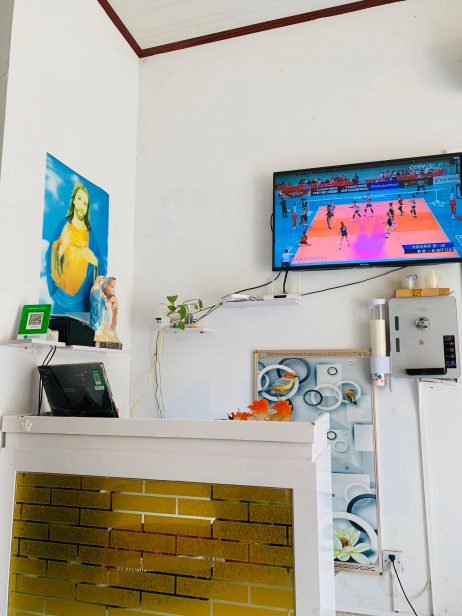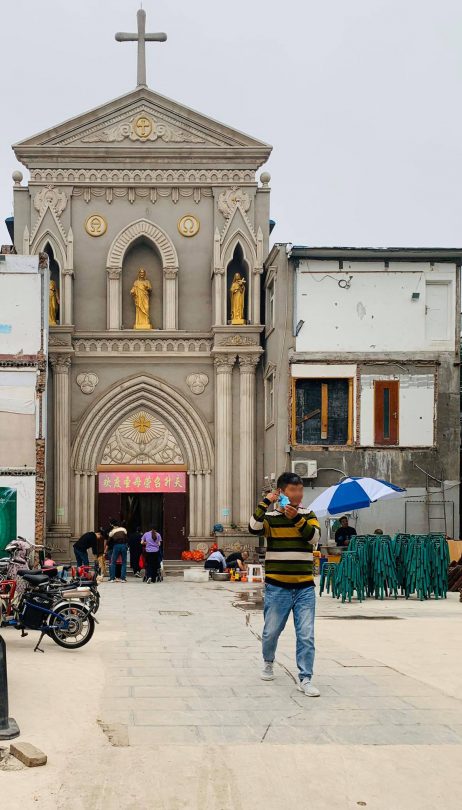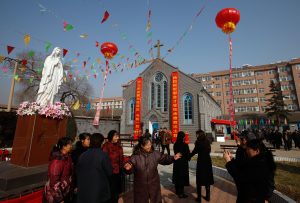Contemporary news coverage has addressed China’s treatment of religious minorities more frequently than ever before, focusing on policies targeting Muslim Uyghurs in China’s northwestern region of Xinjiang. COVID-19 has further complicated the strained relationships both between the Chinese government and several religious communities, and within the communities themselves. Following the international celebration of the Christian holiday of Easter on Sunday, however, it is evident that other religious communities in China continue to survive and support each other in small havens.
One such place is Hebei province, known for having the largest population of Catholics in China, nearly 1 million followers. Hebei has several pockets of religious communities where a large portion of Catholics intermix freely with a broader nonreligious society. Even within families, some members may practice Catholicism while others do not. Nonetheless, Catholicism remains a strong piece of its followers’ identities and community practices.
It is not an easy task to build a strong community and remain nonthreatening to the Chinese government. Hebei Catholics thus maintain their collectivity through less obvious forms of unity, such as wearing cross necklaces beneath their clothes rather than displaying obvious signs of religious adornment. Many joint activities run by the church occur in charity settings, where helping the community and gathering draws less attention and ultimately remains in line with Confucian ideals of placing the collective above one’s self.
While many communal acts occur under the radar, others are much more out in the open. Some hotels in Hebei have small altars in their lobbies. Catholic shopkeepers hang portraits of Jesus Christ inside their stores, whether it be a clothing shop, a food stall, or a foot massage parlor. The emblematic image of Jesus — which has taken the wall space that would typically be occupied by Mao Zedong or another photo of a revolutionary figure from Chinese history — may immediately appear subversive, but it instead serves to connect the Catholic community in Hebei. In this way, religion has seeped into Hebei’s daily life, with Catholics routinely shopping and dining at Catholic-owned enterprises.

A portrait of Jesus Christ alongside a still-wrapped statue of Mary, Joseph, and baby. Seen in a foot massage parlor in Hebei. Photo by Paulina Uznanska.
No matter how quietly strong the Catholic community in Hebei is, the Chinese government ultimately decides whether the community continues or disbands. China and the Vatican have run into numerous conflicts, with the Chinese government routinely attempting to crack down on underground churches and regulating the appointment of bishops. In many areas of society, religious affiliation remains taboo — and even a disadvantage. People in law enforcement positions, for example, are expected to join the Chinese Communist Party (CCP) in order to be promoted. The CCP application form, however, requires a declaration of atheism as a prerequisite for acceptance. As a result, those with religious affiliations must decide between officially disowning their religion or lying on the application form, the latter of which could be later investigated and used against them should they be seen attending religious services.
Broader government regulation of religious practices is not the only development that impacts the Catholic community in China. Hebei province is located in northern China, so the initial restrictions placed in Wuhan (in Hubei province) to combat the spread of COVID-19 did not apply to Hebei. Nonetheless, China’s national measures have changed daily life in Hebei as they have across the country.
To better understand how COVID-19 has impacted Lent and Easter celebrations for the Chinese-Catholic community in Hebei, The Diplomat spoke with Paulina Uznanska, a deputy head of the Polish Research Centre for Law and Economy of China. Uznanska served as a Polish-Mandarin interpreter for a group of Chinese Catholics based in Poland, learning about their practices and community in Hebei. When she moved to China as a Yenching Scholar at Peking University, Uznanska visited a city in Hebei and lived together with Chinese-Catholic community members.
With the rapid spread of COVID-19 in both China and around the world, Uznanska found that Catholics in Hebei have adapted their practices as needed. While transitioning from in-person mass to online services has been a pain for many Western churches, China’s daily life is already much more digitized, making it easier to switch to online-only services. Before COVID-19 hit, phones were already frequently used by mass attendees during the service. Instead of picking up prayer books located in the front of pews, Chinese church goers would look up hymn lyrics on their phones and follow along while scrolling on their screens. When baskets were sent around to collect offerings to the church, you would find a QR code that could be scanned to send money using the Chinese messaging application WeChat, known for its litany of services, including WeChat Pay. Churches also streamed the service for online audiences; however, the live stream was also watched by attendees in the back of the church who were too far away to see the priest.
When COVID-19 emerged, Chinese-Catholic leadership disagreed about appropriate ways to hold religious services. Despite churches having the capabilities to move online and utilize the video streaming services they had already developed and crystallized among their members, several priests disagreed with fully transitioning to online services. One priest in Hebei who opposes online-only offerings told Uznanska this could be “wudao” (误导), or misleading, to regular attendees as watching mass online requires less commitment than attending church in person. Younger generations of Chinese-Catholics — who may not understand the temporary nature of this solution — could become accustomed to “attending” mass only via livestream. Particularly during the Lent season, priests are concerned that the message of sacrifice is more difficult to communicate when the “attendee” is watching the video from the comfort of home. While churches in cities like Beijing may not be able to get away with skirting COVID-19 restrictions, some churches in smaller cities are holding informal, unpublicized in-person masses.
Some services cannot be as easily moved online, such as confession. Confession, or the admission of one’s sins to a priest for absolution, typically occur in a confessional that places the priest and the penitent in relatively close contact on either side of a screen. Confession may not be available online, but priests are nonetheless obliged to conduct confessions if churchgoers request them. Even after restrictions were implemented throughout China, it was still possible to organize a confession. These informal services of unadvertised masses and quietly scheduled confessions have helped local churches maintain a physical presence during a time marked by primarily digital connection.
Community-based initiatives have been similarly and disproportionately affected by the new restrictions. Many of the charities run by local priests and nuns could not simply be abandoned, including a local home for disabled orphans. But other activities have been cancelled, including annual religious training provided to local teenagers. Although churches have organized charity drives, including collecting resources for those suffering in Wuhan, the church’s presence in the community has left a noticeable hole.

A man puts on a face mask upon leaving a church in Hebei. Photo by Paulina Uznanska.
The largest change for the Chinese-Catholic community, however, has been the shift from daily interactions in public to structured practice in private homes. Uznanska noted that Chinese-Catholic communities typically rely on face-to-face interactions, whether on the street or at church services. This “street culture” is common throughout tight-knit communities in China regardless of religion, with Beijing’s old neighborhoods (known as hutongs) setting a prime example.
In Hebei, informal community-building manifests in the most mundane moments. People wearing crosses may be openly approached on the street by fellow Catholics and asked if they are believers. Uznanska was washing her hands when a cleaner noticed she was wearing a cross necklace and struck up a casual conversation. This interaction is not meant for the conversion of nonbelievers, but rather to make connections with fellow believers in a society that does not regularly or openly discuss religious affiliations.
Establishing connections provides the same sense of community that is a cornerstone of religious traditions around the world, making it easier to observe and practice religious customs. For example, orthodox Catholics typically feast on Fridays and refrain from working on Sundays. These rules can become more strict around certain holidays. In the six weeks that precede Easter, Catholics observe Lent to repent their sins. Lent consists of routine fasting alongside refraining from engaging in certain luxuries, such as desserts or alcohol. Considering 700 million Chinese have no religious affiliation, Uznanska notes that a stronger sense of community can make it easier to follow these regulations when you are around people who follow the same rules — or at least understand them.
While the Catholic community is typically built within the church, the church is now manifesting in the private homes of Chinese-Catholics. Many priests are encouraging the members of their churches to pray at home more frequently as a family. Regular churchgoers have maintained consistent contact through WeChat messaging groups, sharing photos of their families handwriting biblical scripture and sharing favorite passages from provided weekly readings organized through smaller Bible study groups. These practices may have started before COVID-19 restrictions, but they have inevitably grown during this transition from public to private worship.
Easter celebrations for Chinese-Catholics usually seek to reconcile a celebration of the collectivity that strengthens their community with the need to remain inconspicuous in the eyes of the Chinese government. This year, Easter Sunday celebrations inevitably hold different meaning as Catholic havens throughout China look forward past COVID-19 restrictions and decide how their communities will emerge on the other side.
For further information on Catholicism in China, connect with Paulina Uznanska on LinkedIn, Twitter, or email.

































